The Snake Plant is believed to be almost indestructible, since the growth patterns are so small…
However, let me remind you that there is a sure-fire way to kill your Snake Plant, and that is to let the roots rot…
You must be careful not to overwater your Snake Plant if it is in a pot without drainage holes…
… as excess water will stay in the pot and cause its roots to rot.
Hear it from Ben!
The first time I have my snake plant, I killed it…
As a beginner in gardening, I thought that plants always need watering…
… every morning and afternoon of everyday.
One day, I found my snake plant drooping its leaves…
… and showing signs of sadness.
Eventually I learned, that my snake plant was overwatered…
It is said that overwatered snake plants are commonly un-revivable…
… so I cannot do much about it.
I also didn’t notice that the pot I plant my snake plant in…
… didn’t have drainage holes for excess water to pass by.
Hence, it adds up to the possibility of overwatering…
At least now I’ve learned from that mistake and try to be a better plant parent…
But wait…
You can still, however, plant your snake plant in containers without drainage holes…
Snake Plants in containers do not need drainage holes in their pots…
… but they will be much easier to maintain in a pot with holes.
Used with drainage holes, Snake plants will be more resistant to root rot, their biggest killer…
Let’s get deep…
Why Is Drainage Important?

The drainage holes in the bottom of a container are crucial for most container plants, including Snake Plants…
Drainage holes allow excess water to flow out of the container and prevent a soggy potting mix…
A few small holes in the bottom will provide for drainage; but with carefulness in watering these are not necessary, since the box by its exposed position will dry out readily during summer weather, unless the position is a shaded one. In the latter case provision for good drainage is always advisable.
L. H. Bailey, Author of Manual of Gardening
Furthermore, moving water through the potting mix is crucial to preventing the build up of chemicals…
… in fertilizers and tap water that can harm your plants’ roots.
In pots with no drainage holes, water can accumulate in your plant’s container, causing damage to it…
The Snake Plant will suffer as a result…
Problems Caused By Lack Of Drainage
Snake Plants grown in pots without drainage holes may suffer from a number of issues…
Here are these issues in detail:
Root Rot

The constant moisture in container plants’ potting mix enables fungal organisms to breed, resulting in root rot…
Family members of the Pythium, Phytophthora, Fusarium, and Rhizoctonia fungi are the most common…
Waterlogged containers are a perfect breeding ground for these fungi…
… which multiply and devour your plants’ roots rapidly, causing severe damage to your plant.
The signs of root rot are similar to those of dehydration – dry, curled, and drooping leaves…
Before watering, test the water level in the Snake Plant’s potting mix…
… as adding more water will only make the problem worse.
For root rot, determining the fungus and symptoms…
… as well as the same treatments for each, is not necessary.
Oxygen Starvation
In addition to carbon dioxide, plants also require oxygen to survive…
While this is true, it’s a lesser known fact that plants need both…
They are able to take in carbon dioxide and oxygen through their leaves…
… through pores known as stomata, as well as via their roots.
The roots of a plant that is surrounded by water, such as that found in waterlogged soil…
… do not have enough oxygen and begin to suffocate.
When your plant is Oxygen deficient, you will notice stunted…
… yellow leaves that eventually fall off, and eventually the plant will die.
Root rot and oxygen deficiency go hand in hand, so if your plant has one and both…
… chances are good that it will also have the other.
Root Burn from Excess Salts and Minerals
Snake Plants that are grown in pots without drainage holes…
… are much more prone to suffer from chemical buildups and root burn.
Salts and minerals contained in tap water and fertilizers…
… may be beneficial to plants in very small doses, but potentially harmful in large quantities.
Root burn occurs when moisture can’t escape your plant’s pot…
… causing substances to accumulate around the roots.
This damages the roots and prevents them from functioning properly…
Affected plants may have brown leaves and roots and experienced stunted growth…
Weak Root System Development
It is important for your Snake Plant to have a healthy root system…
If the roots are submerged in water, your plant is susceptible…
… not only to the problems listed above, but it is also not able to grow new strong roots.
You’ll be unable to maximize your plant’s potential without a healthy root system…
It may lose leaves, droop, or even die without enough nutrients coming through the roots…
How To Treat Drainage Problems?
If you suspect any of these problems, you need to take action right away…
All of these issues could cause your plant to die within a few weeks…
To give your plant the best chance, make sure the water level in the pot is kept at a constant level…
- Removing as much soil around the roots of your plant as you can is the best way to care for it.
- Remove rotten or damaged roots with a pair of sterilized, sharp scissors.
- You should wash off any crusty chemical buildup around the roots with water if you see it.
- If possible, repot your plant into a very slightly moist, well-draining soil mixture (use 1/3 perlite or vermiculite to improve drainage).
- Plants suffering from poor drainage should be placed in containers with holes for drainage.
- The potting mix should not be dry if your plant isn’t watered; so water sparingly or check it before watering!
Pebble Tray

You will be able to allow water to move down into the gravel, pebbles…
… or charcoal in the pot if you place two inches of gravel, pebbles, or charcoal in the bottom of the pot.
Broken pottery isn’t ideal for this purpose – the shape of the fragments makes it hard for water…
… to penetrate and will often accumulate over time in the mix, increasing the waterlogging problem.
Adding a Layer of Activated Charcoal to the Potting Mix
Activated charcoal absorbs water and improves drainage for your Snake Plant…
… pulling water from the soil and keeping it away from the roots.
It will hold the water away from your plant’s roots…
As you pot your plant, layer charcoal into the soil…
Note that activated charcoal is different from barbecue charcoal…
… which may have been treated with chemicals.
Activated charcoal can be found at aquarium supply shops, garden centers, and online…
Mixing Perlite or Vermiculite to the Potting Mix

Volcanic rocks like perlite and vermiculate absorb water from the soil…
… and keep it away from plant roots much like charcoal.
Porous substances such as these also contain air…
… which your plant’s roots benefit from in order to absorb oxygen.
You can buy perlite and vermiculite in garden centers or online…
Combine one-third perlite and vermiculite with your potting compost when potting your plants…
Moreover…
You should use a pot with drainage holes if you plan on keeping Snake Plants in pots without drainage holes…
Pots should be small enough so that water won’t remain in the bottom for more than 24 hours…
… a six-inch-diameter container works well for a medium-sized plant.
For the Snake Plant to evaporate properly, place it in a spot with enough bright indirect light (55 – 85°F, 13 – 29°C)…
… so that it gets a lot of direct light, such as a window.
You should repot your Snake Plant once a year if you keep it in a container…
… without drainage holes so you can check its root system.
In order to avoid root problems, you might want to repot your plant into a container with drainage holes…
… if you notice black or brown sections on the roots.
How To Water Your Snake Plant Without Drainage Holes
You should adjust your watering technique if you decide to keep your plant in a container without drainage holes…
Compared to other plant species Snake Plants can be drought tolerant…
… requiring little water to survive, and can be significantly damaged…
… by overwatering instead of underwatering.
Water the plant once a month to once every three months…
… depending on the conditions in which you keep it.
Summer temperatures are usually high enough that your plant only requires watering…
… about once a month, possibly even less.
Autumn and winter temperatures are cooler…
… so you might just need to water your plants about every two or three months.
The following tips will help you water your Snake Plant if you keep it in a pot without holes for drainage:
Check the Moisture Content of Potting Mix Before Watering
Only water your snake plant when the potting mix is completely dry…
You can check the moisture level in the mix with your finger by pressing down on the surface…
If any moisture is detected, you can water the plant…
You can also use a hydrometer for this purpose…
Use a Syringe or Spray Bottle to Water Your Plant

You can dose your plants accurately by either injecting water directly…
… into the potting mix or spraying water directly onto the top layer.
Remove Excess Water When Possible
For example, if water has built up near the potting mix on your Snake Plant…
… and you think you’ve overwatered, gently tip the pot so that the water can drain.
Never Water Your Plant on a Schedule or ‘Just in Case’
The easiest way to kill your Snake Plant is to give it water when it doesn’t need it…
If you’re tempted to top it off without first checking, resist the urge…
Snake Plants can do well without water even if you forget to give them some…
They won’t suffer if you miss one or two waterings…
Is It Better To Grow Snake Plants In Pots With Or Without Drainage Holes?
The choice is yours whether you plant your Snake Plant in an pot with or without drainage holes…
Pots with drainage holes are much less prone to problems caused by overwatering…
… but Snake Plants grow happily in containers without them.
You should be mindful of root problems and pay closer attention to your plants…
Beginners or those who overwater often might want to use pots with enough drainage holes…
… in order to err on the side of caution.
To sum it up…
There is a simple solution if you like the look of decorative containers without drainage holes…
… but are worried that they will harm your plant.
It is very easy to pot Snake Plants in pots with lots of drainage holes…
… place a layer of gravel or pebbles in containers without holes, and pop your plants inside.
Water will drain out through the drainage holes of your plant’s pot into the other container…
The secret to keeping your plant healthy is to avoid overwatering…
… but if you do overwater your plant, this technique makes it easier to get rid of the excess water.
Conclusion
If you still have any queries on the matter…
… or in need of further information…
… you can comment down below or contact us.
Check out more posts on our website like this one here!
Have an awesome gardening journey!


